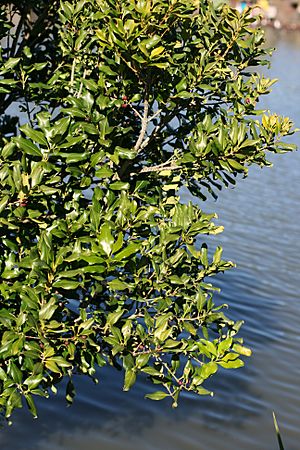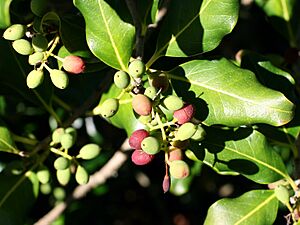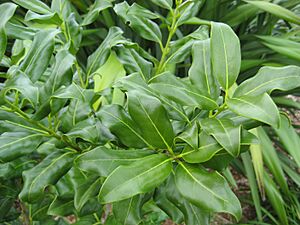Coastal maire facts for kids
Quick facts for kids Coastal maire, ironwood |
|
|---|---|
 |
|
| Scientific classification | |
| Genus: |
Nestegis
|
| Species: |
apetala
|
| Synonyms | |
|
Olea apetala Vahl. |
|
The Nestegis apetala is a small tree. It is also known as coastal maire or broad-leaved maire in New Zealand. On Norfolk Island, people call it ironwood. The name apetala means "without petals." This is because its flowers do not have petals. This tree grows naturally in northern New Zealand and on Norfolk Island.
Contents
Where Does the Coastal Maire Grow?
In New Zealand, you can find N. apetala on the North Island. It grows on rocky areas around Whangarei Heads and in the Bay of Islands. It also lives on islands near the coast. These include the Hen and Chickens Islands, Great Barrier Island, Little Barrier Island, and the Poor Knights Islands. It is less common on islands where rats live. On Norfolk Island, it is often found on Mt Pitt. It also grows in many forested areas there.
What Does the Coastal Maire Look Like?
The Nestegis apetala can be a shrub or a tree. It can grow up to 6 meters (about 20 feet) tall. Its leaves are smooth, shiny, and dark green. They are usually 4.5 to 12 cm long. Young leaves can be even bigger. The leaves often have a wavy edge.
The flowers of N. apetala grow in small clusters. Up to 21 flowers can grow together. Each flower is tiny, about 2.5 mm wide. They do not have petals. The fruit is a small, round berry. It is about 9 mm long. When ripe, it can be red, yellow, or sometimes purple. The New Zealand Plant Conservation Network says this plant is 'Not Threatened'. This means it is not currently in danger of disappearing.
Why Are Coastal Maires in Danger?
The fruits and seeds of N. apetala are tasty to rats. In New Zealand, a type of rat called the kiore (or Polynesian rat) eats these seeds. These rats were brought to New Zealand by Māori long ago. They spread across many islands. When rats eat the seeds, it stops new trees from growing. This makes the number of coastal maire trees go down.
Today, the coastal maire is quite rare on the main islands of New Zealand. But scientists think it was once very common. This was before the kiore rats arrived. On islands where kiore are present, like Hen Island, young coastal maire plants are rare. But on islands without kiore, like the Poor Knights Islands, many young plants grow.
For example, on Cuvier Island, kiore rats were removed. Three years later, many new N. apetala seedlings started to grow near older trees. This shows how much rats affect the tree's survival. However, if there are not many fruiting trees left, it can take a long time for the population to grow back. This is because there are fewer seeds to spread.
How Are Coastal Maires Used?
The Nestegis apetala is a beautiful small tree. It is known for its very hard wood. Birds enjoy eating its berries. In New Zealand, you can buy these trees from special plant nurseries.



